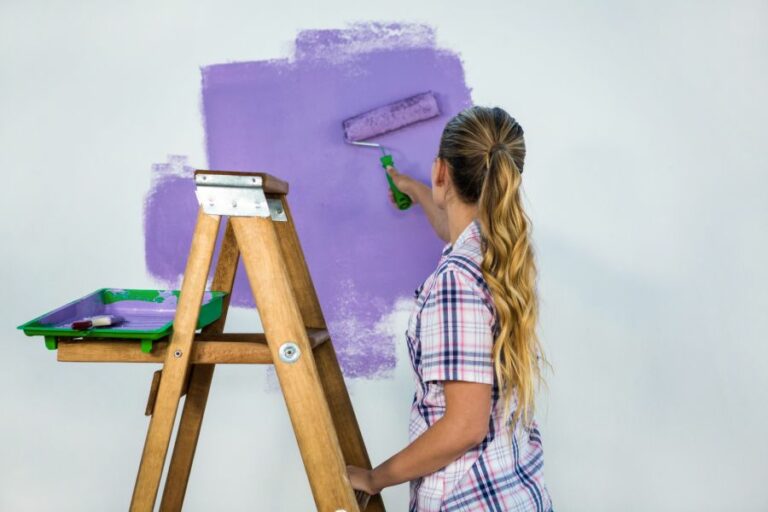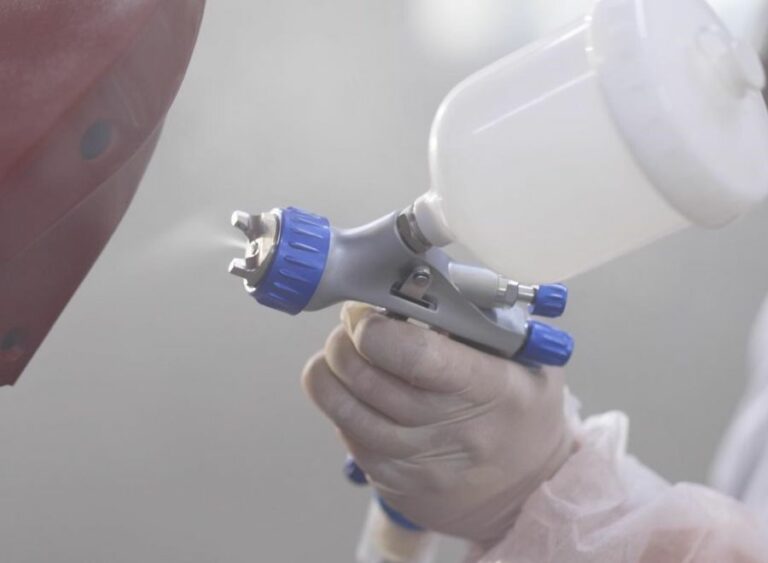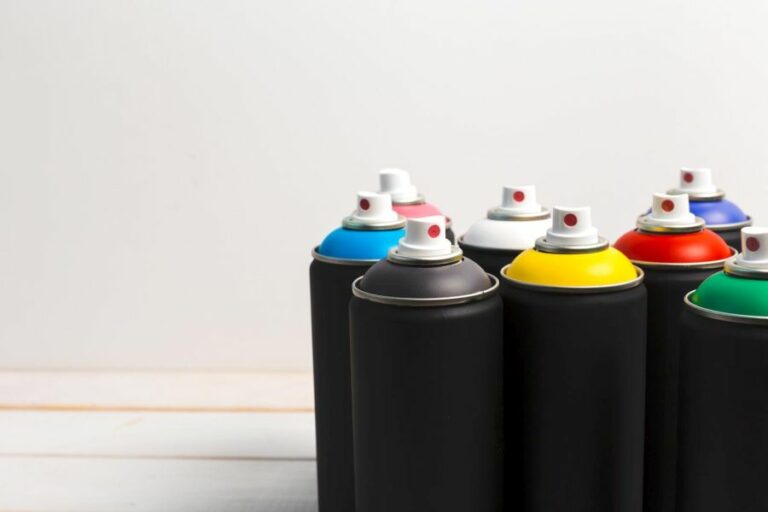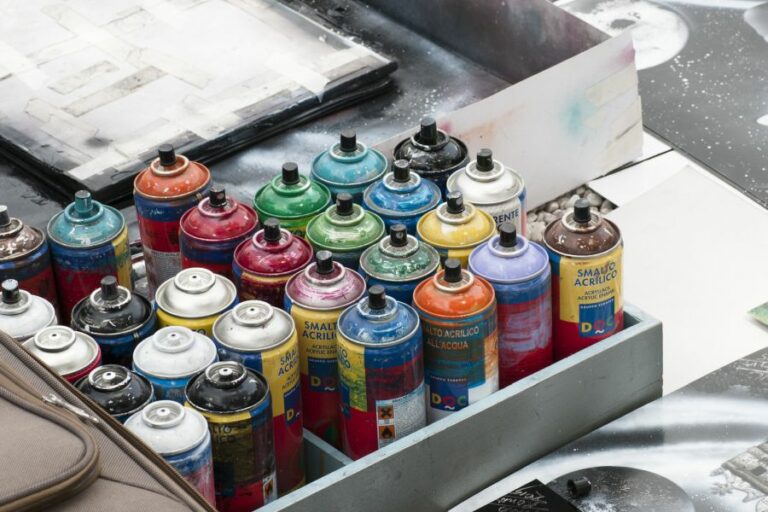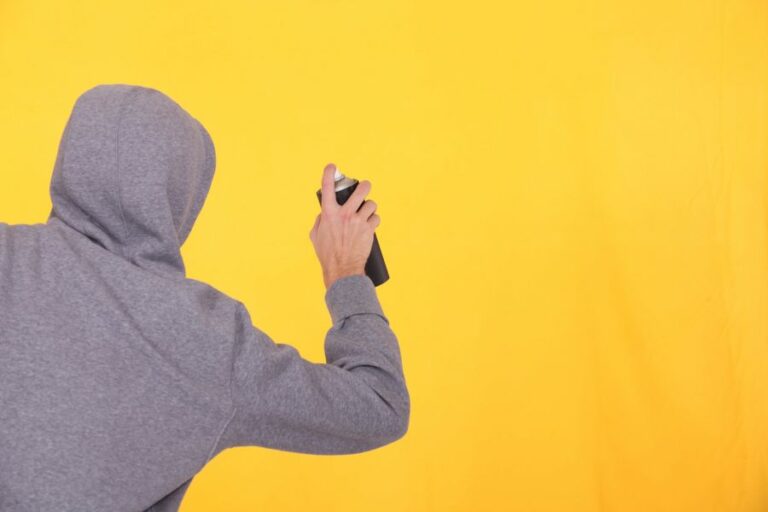Clean Spray Paint Off Various Surfaces. What Pros Say
Tackling the challenge of removing spray paint from different surfaces may seem daunting, but fear not! You can restore your surfaces to their pristine state with tried-and-true cleaning methods and some elbow grease. In this discussion, we’ll dive into various techniques to effectively remove spray paint from multiple surfaces, providing you with the knowledge and confidence to tackle any unwanted graffiti or accidental overspray.
Clean spray paint off various surfaces:
To clean spray paint off various surfaces, use the appropriate solvent, such as paint thinner or acetone, and gently rub the affected area. For wood and plastic, test the solvent on a small area first. Scrape off loosened paint with a plastic scraper, then clean the surface. For glass, use a razor blade to scrape off paint and a glass cleaner afterward. For fabric, blot or rub the solvent and rinse before washing.

Discover the most effective methods to remove spray paint from various surfaces, including glass, metal, and brick. Uncover proven techniques and products that work wonders! Keep reading to restore surfaces with ease and precision.
Contents
- 1 Effective Methods for Removing Spray Paint from Surfaces
- 2 Discover the Best Techniques to Eliminate Spray Paint
- 3 Master the Art of Removing Paint from Every Surface
- 4 Learn the Process of Scrubbing Off Spray Paint
- 5 Expert Guide to Clean Spray Paint from Hardware
Effective Methods for Removing Spray Paint from Surfaces
Cleaning spray paint off surfaces can be a daunting task, especially for those who aren’t familiar with the process. However, with the right techniques and tools, it can be done effectively and efficiently.
• Cleaning Spray Paint from Wood
Wood is a porous material, making it challenging to remove spray paint from it. Follow these steps to clean spray paint off wood:
1. Start with a Test Area
Before applying any cleaner or solvent, test the solution on a small, inconspicuous area to ensure it doesn’t damage the wood or its finish. If the test area doesn’t result in any damage or discoloration, proceed to the next step.
2. Use a Paint Thinner or Solvent
Choose a paint thinner or solvent suitable for the type of paint you’re trying to remove, such as acetone, mineral spirits, or denatured alcohol. Apply the solvent to a clean cloth or sponge and gently rub the affected area, working in a circular motion.
3. Scrape Off the Paint
Use a plastic scraper or putty knife to carefully scrape away the loosened paint. Ensure you use a plastic tool to avoid scratching the wood surface.
4. Sand the Area
Lastly, sand the area with fine-grit sandpaper to remove any remaining paint and smooth the wood. Be sure to follow the grain of the wood to avoid adding any scratches to the surface.
• Cleaning Spray Paint from Metal
Removing spray paint from metal surfaces is slightly easier because metals are non-porous. Follow these steps:
1. Use a Paint Thinner or Solvent
Choose a paint thinner, acetone, or rubbing alcohol, and apply it to a clean cloth or sponge. Gently rub the affected area in a circular motion, keeping in mind that acetone can weaken certain plastics, so avoid using it on plastic components.
2. Scrape the Paint Off
Use a plastic scraper or your fingernail to carefully scrape off the loosened paint. Do not use a metal scraper as it can damage the metal surface.
3. Apply a Second Coat of Solvent (If Needed)
If necessary, apply a second coat of solvent and continue rubbing until all the paint is removed.
4. Clean the Metal Surface
Once the paint is removed, clean the metal surface with soap and water or metal cleaner.
• Cleaning Spray Paint from Glass
Glass surfaces are quite easy to clean spray paint off since they’re non-porous and smooth. Here are the steps:
1. Scrape the Paint Off
Using a razor blade or flat-edged scraper, carefully scrape the paint off the glass surface. Ensure the blade is flat against the glass to avoid scratching the surface.
2. Use a Glass Cleaner
After scraping the paint off, clean the glass with a glass cleaner and a soft cloth to remove any residue.
• Cleaning Spray Paint from Plastic
Plastic surfaces can be challenging due to their potential to be damaged by harsh chemicals or solvents. Follow these steps:
1. Test the Solvent on a Small Area
As with wood, test your chosen solvent (such as rubbing alcohol or mineral spirits) on a small, inconspicuous area to ensure it doesn’t damage the plastic.
2. Apply Solvent and Rub
Apply the solvent to a clean cloth or sponge, and gently rub the affected area.
3. Scrape Off the Paint
Use a plastic scraper or your fingernail to carefully remove the loosened paint.
4. Clean the Plastic Surface
Finally, clean the plastic surface with soap and water or a plastic cleaner.
• Removing Spray Paint from Fabric and Upholstery
Removing spray paint from fabric and upholstery can be tricky, but it’s possible with the right approach. The University of Illinois Extension provides a detailed guide on removing paint stains from fabrics, including spray paint.
1. Test the Solvent
As with wood and plastic, test your chosen solvent on a small, hidden area of the fabric to ensure it doesn’t damage or discolor the material.
2. Blot or Rub the Solvent
Blot (for delicate fabrics) or gently rub (for more durable materials) the solvent onto the affected areas using a clean cloth or sponge. Avoid excessive rubbing or scrubbing, as this can damage the fabric.
3. Rinse and Wash
Rinse the fabric with cold water, then machine or hand wash as usual.
• In Conclusion
Cleaning spray paint off various surfaces requires a combination of the right techniques, tools, and solvents to effectively and safely remove the paint.
Always remember to test your chosen solvent on a small, inconspicuous area before applying it to the entire affected area. With patience and persistence, you can successfully clean spray paint off wood, metal, glass, plastic, and fabrics.
Discover the Best Techniques to Eliminate Spray Paint
Regardless of the intention behind spray painting, it’s crucial to know how to remove the paint effectively and safely, ensuring no damage to the surface.
• Spray Paint Removal from Non-Porous Surfaces
Non-porous surfaces are those that do not absorb liquids, such as glass, metals, and certain plastics. Their smooth and unabsorbent nature makes it easier to remove spray paint from these surfaces.
– Using a Paint Scraper or Razor Blade
For glass, metal, and hard plastic surfaces, carefully using a paint scraper or razor blade can efficiently remove spray paint. The key here is to work gently and patiently so as not to scratch the surface.
Steps to follow:
- Use a clean cloth to wipe away any dust or dirt from the surface.
- Hold the paint scraper or razor blade at a 45-degree angle to the surface.
- Apply gentle pressure and push the tool under the paint while moving it back and forth.
- Continue scraping the paint until it is completely removed.
- Clean the surface with water and soap, then dry it with a clean cloth.
– Using Paint Thinner or Acetone
Caution: Wear gloves and work in a well-ventilated area when using paint thinner or acetone.
These chemicals are strong solvents that dissolve spray paint on surfaces such as metal and hard plastics. Using a cloth soaked with paint thinner or acetone, gently rub the paint-affected area until it dissolves.
Steps to follow:
- Pour paint thinner or acetone onto a clean cloth.
- Gently rub the cloth on the spray paint area until the paint dissolves.
- Use a dry cloth to wipe away any residue.
- Clean the surface with water and soap, followed by drying with a clean cloth.
• Spray Paint Removal from Porous Surfaces
Porous surfaces, including wood, concrete, and brick, are known to absorb liquids, making the removal of spray paint slightly more challenging. Here are some methods to remove paint from such surfaces.
– Using a Power Washer
Power washing is a suitable method for outdoor surfaces such as concrete and brick, as it uses high-pressure water to blast away paint residue. Choose a power washer with a PSI (pounds per square inch) of at least 3,000 for effective paint removal.
Steps to follow:
- Adjust the washer nozzle to create a high-pressure stream of water.
- Set the power washer to a low setting.
- Hold the nozzle at a 45-degree angle, approximately 12 inches away from the surface.
- Test the pressure on an inconspicuous area to ensure it doesn’t damage the surface.
- Gradually increase the pressure, and work your way closer to the surface as needed.
- Move in swift and consistent strokes to remove the spray paint.
– Using a Paint Stripper
Paint strippers are effective in removing spray paint from wood, brick, and concrete surfaces. Choose a paint stripper specifically formulated for the surface you’re working on. Gel-based paint strippers are particularly useful, as they cling to vertical surfaces and penetrate the paint layers.
Steps to follow:
- Apply the paint stripper onto the spray-painted area using a paintbrush.
- Leave the paint stripper on for the recommended time as per the product instructions.
- Use a paint scraper or brush to scrape away the softened paint.
- Clean the surface with water and soap, followed by drying with a clean cloth.
- Repeat the process if necessary.
• Spray Paint Removal from Fabric
Spray paint stains on fabric can be tricky to deal with, but acting quickly can save the material.
– Using a Solvent
Alcohol-based solvents like rubbing alcohol (isopropyl alcohol) or nail polish remover (acetone) can assist in removing spray paint from fabric.
Steps to follow:
- Lay the fabric on a flat surface with the stained side up.
- Blot the paint stain with a clean cloth to remove excess paint.
- Apply rubbing alcohol or nail polish remover to a clean cloth.
- Blot the stained area with the solvent-soaked cloth to dissolve the paint.
- Rinse the area with cold water, ensuring that the solvent and paint residue is removed.
- Wash the fabric according to the care label instructions.
Note: Act promptly to remove stains from fabric, as the paint will be harder to dissolve once it dries.
• A Final Note
Different surfaces require different techniques for removing spray paint. Being equipped with the correct knowledge and tools, along with patience and caution, can effectively salvage surfaces from spray paint mishaps or vandalism.
Always test a method in an inconspicuous area before proceeding, and if unsure, consult a professional.
Master the Art of Removing Paint from Every Surface
Removing paint from various surfaces can be a tricky task, but with the right tools and techniques, you can make the process much easier.
• Removing Paint from Wood
Wood can be damaged easily if not handled properly during the paint removal process. Therefore, it’s essential to use the right tools and techniques to prevent any permanent damage.
– Steps for Removing Paint from Wood:
- Begin by sanding the surface: When dealing with wooden surfaces, sanding can be a highly effective way to remove paint. Fine-grit sandpaper (120-150 grit) is recommended to start, and you can gradually increase the grit as needed, all the way up to 220 grit. Make sure to sand in the direction of the wood grain to avoid leaving any scratches.
- Apply a paint stripper: If sanding alone isn’t efficient in removing paint from a wooden surface, you can opt to use a paint stripper. Choose a non-toxic, biodegradable, and eco-friendly paint stripper for a safer option. Apply the paint stripper according to the manufacturer’s instructions and allow it to properly work its way through the paint layers.
- Remove the softened paint: Once the paint stripper has had enough time to penetrate the paint (this can vary from a few minutes to a few hours), you can remove the loosened paint using a plastic scraper or a putty knife. Avoid using metal scrapers, as they can easily damage the wood.
- Clean the surface: Once the paint has been removed, clean the surface using a damp cloth and mild soapy water. Allow the wood to dry completely before proceeding with any new paint or treatments.
– Protective Measures:
Always wear protective gear such as gloves, safety goggles, and a mask when removing paint from wood, as paint stripper fumes can be toxic.
• Removing Paint from Metal
Metal surfaces require a different approach to remove paint effectively. These steps will help you get the job done with minimal hassle.
– Steps for Removing Paint from Metal:
- Apply a paint remover: Choose a paint remover that is specifically formulated for metal surfaces. Apply a generous amount of the product to the painted area, following the manufacturer’s instructions.
- Allow the paint remover to work: Give the paint remover ample time to break down the paint layers (this can vary from 20 minutes to a few hours, depending on the product). Be patient and avoid rushing the process, as this can lead to uneven results.
- Remove the paint using a scraper: Once the paint has softened, use a plastic scraper or a putty knife to gently remove it from the metal surface.
- Clean the surface: After the paint has been removed, clean the metal surface thoroughly using a damp cloth and mild soapy water. Allow it to dry fully before repainting or treating the metal.
– Protective Measures:
Ensure proper ventilation when working with paint removers, and wear gloves and safety goggles for protection.
• Removing Paint from Bricks
Brick surfaces can be somewhat challenging when it comes to paint removal, as they are porous and uneven. However, with the right approach, you can successfully remove paint from brickwork without causing damage.
– Steps for Removing Paint from Bricks:
- Apply a paint stripper for masonry: Use a paint stripper specifically designed for brick or masonry surfaces. Apply the product following the manufacturer’s instructions and allow it to work its way through the paint layers.
- Scrub the surface with a stiff brush: Once the paint has softened, use a stiff-bristled brush (e.g., nylon or stainless steel) to remove the loosened paint. The brush will help you tackle the uneven surface and get into the small crevices of the brick.
- Rinse the surface: After removing the majority of the paint, rinse the brick surface thoroughly using clean water. A power washer can be effective in achieving an even and thorough clean.
- Neutralize the paint stripper: If the paint stripper used requires neutralization, make sure to apply the appropriate neutralizing agent. This will help prevent damage to the bricks and ensure a clean surface for any future treatments.
– Protective Measures:
When dealing with brick surfaces, always wear protective gloves, safety goggles, and a mask to protect yourself from potential harm.
• Final Thoughts
Removing paint from various surfaces can be a challenging and time-consuming task. However, with proper tools, techniques, and patience, you can get the job done effectively and safely.
Always wear the appropriate protective gear and follow the manufacturer’s guidelines for any specific products you use. For further resources on paint removal, consult expert resources such as those provided by the EPA.
Surface | Method |
|---|---|
Wood | Use a paint stripper, sandpaper, or a heat gun |
Metal | Use a chemical paint remover or a wire brush |
Plastic | Use rubbing alcohol or a plastic-safe paint remover |
Glass | Use a razor blade or a glass-safe paint remover |
Concrete | Use a pressure washer, a stripper, or a soy-based gel |
Brick | Use a paint stripper, a wire brush, or a pressure washer |
Textiles | Use a paint thinner or a fabric-safe cleaner |
Leather | Use a leather cleaner or a gentle soap and water solution |
Learn the Process of Scrubbing Off Spray Paint
Spray paint is a versatile and convenient medium for creating art, making repairs, or adding a touch of color to a variety of surfaces. However, sometimes the end result isn’t what was originally desired, or perhaps the paint ends up on an unintended surface.
In such cases, knowing whether spray paint can be scrubbed off becomes a crucial question. The short answer is yes, but the ease and effectiveness of the process depend on several factors, the primary ones being the type of surface and the type of paint.
– The Type of Surface Matters
Porous surfaces
Porous surfaces, such as concrete, brick, and natural stone, can be more challenging when it comes to removing spray paint. These materials have a lot of tiny holes and crevices that can trap paint, making it much more difficult to scrub off.
In some cases, a combination of chemical paint remover, stiff-bristle brushes, and pressure washing might be required.
Non-porous surfaces
Non-porous surfaces, such as metal, glass, and smooth plastics, are generally easier to clean since they don’t have the same kind of texture that traps paint.
In many cases, a combination of mild detergent, water, and a soft cloth or sponge should be sufficient to remove spray paint from these surfaces. More stubborn stains may require the use of a paint remover or a razor blade to scrape off the paint.
Painted surfaces
In some cases, spray paint may need to be removed from an already painted surface, such as a wall or a piece of furniture. This can be a bit more complicated, as the goal is to remove the spray paint without damaging the underlying paint job.
Using a mild detergent and water-cleaning method is the least likely-to-damage approach, but if that doesn’t work, a careful application of a paint remover may be required.
– The Type of Spray Paint Matters
Water-based spray paint
Water-based spray paint, also known as acrylic or latex paint, is generally easier to remove because it is less resistant to water and is not as likely to bond as tightly with surfaces. Most water-based spray paint can be removed using the soapy water and soft cloth or sponge method mentioned above.
Oil-based spray paint
Oil-based spray paint, also known as enamel or alkyd paint, is more difficult to remove due to its chemical composition. In this case, a paint remover or solvent should be used along with elbow-grease-aided scrubbing for effective removal.
Always remember to stay safe by wearing protective gloves and eyewear when working with potentially hazardous chemicals.
– Tips for Effective Spray Paint Removal
- Act quickly: The sooner the spray paint is addressed, the easier it is to remove. Fresh paint is less likely to have fully bonded with the surface, making it easier to scrub off.
- Be gentle: When trying to remove spray paint from a surface, especially a painted one, it’s best to start with the gentlest cleaning method (such as soapy water and a soft cloth) and work your way up to more aggressive approaches.
- Test in a small area: Before applying any chemical or method to remove spray paint, it’s a good idea to perform a spot test on a small, inconspicuous area. This will allow you to check that the cleaning approach won’t damage the surface or make the situation worse.
• In Conclusion
While the prospect of removing spray paint might seem daunting initially, it is indeed possible to scrub it off in most cases.
By considering the type of surface and spray paint involved and employing the appropriate cleaning methods, one can effectively restore the affected area to its original state.
Expert Guide to Clean Spray Paint from Hardware
Spray paint is a convenient and versatile solution for various DIY projects, but unintentional overspray can create unwanted blemishes on hardware.
Learning how to remove spray paint from different hardware surfaces effectively and safely will help preserve the original appearance and functionality of your devices.
• Safety Precautions
Before beginning any spray paint removal process, it is essential to collect and wear appropriate personal protective equipment (PPE). Gloves and safety goggles are necessary to ensure your safety while working with chemicals, solvents, or abrasive materials.
Additionally, work in a well-ventilated area to minimize the risk of inhaling harmful fumes.
• Removing Spray Paint from Metal Hardware
Metal hardware, such as door handles, hinges, and locks, are common victims of paint overspray. The following methods can effectively remove spray paint from metal surfaces without harming the finish:
– Using Paint Thinner or Turpentine
- Moisten a clean cloth with paint thinner or turpentine. Both solvents are readily available in hardware stores and are known for their paint-removing properties.
- Gently rub the spray-paint-affected area with the moistened cloth. Apply consistent pressure while ensuring not to scratch the metal surface.
- Wipe the area with a dry cloth to remove any remaining paint and solvent residue.
- If necessary, repeat the process until the spray paint is completely removed.
Note: Use caution when handling chemicals like paint thinner and turpentine. Follow the manufacturer’s instructions and safety precautions, such as wearing gloves and protective eyewear.
– Using a Fine Steel Wool
- Moisten a piece of fine steel wool with warm water and mild detergent.
- Gently scrub the spray paint off the metal surface with the steel wool without applying too much pressure to avoid scratching.
- Wipe the area clean with a dry cloth and check if the paint has been removed.
- If necessary, repeat the process until the spray paint is completely removed.
Note: Fine steel wool is recommended as it is less abrasive and less likely to scratch the metal’s surface.
• Removing Spray Paint from Plastic Hardware
Plastic hardware can be more challenging to clean due to the delicate nature of the material. Using harsh chemicals or excessive force may cause damage. Here are some gentle methods for removing spray paint from plastic hardware:
– Using Rubbing Alcohol
- Dampen a clean cloth with rubbing alcohol (isopropyl alcohol).
- Gently dab the affected area with the alcohol-soaked cloth, avoiding excessive rubbing or pressure.
- Allow the alcohol to sit for a few minutes to break down the paint.
- Wipe the area with a clean, dry cloth to remove the dissolved paint.
- If necessary, repeat the process until the spray paint is completely removed.
– Using a Plastic Scraper or Fingernail
- Carefully use a plastic scraper or your fingernail to chip away at the spray paint on the plastic surface.
- Apply gentle, consistent pressure to avoid damaging the underlying plastic.
- Wipe the area with a clean cloth to remove any paint residue.
- If necessary, repeat the process until the spray paint is completely removed.
• Removing Spray Paint from Glass Hardware
Glass hardware, such as windows, mirrors, and light fixtures, can be cleaned using the following techniques:
– Using a Razor Blade Scraper
- Hold the razor blade scraper at a 45-degree angle against the glass surface.
- Gently scrape the spray paint from the glass in one direction, lifting the blade after each stroke.
- Wipe the area with a clean cloth to remove paint residue.
- If necessary, repeat the process until the spray paint is completely removed.
Note: Use caution when handling a razor blade scraper to avoid injury and ensure it is used only on glass surfaces that won’t be damaged or scratched.
– Using Nail Polish Remover
- Apply a small amount of acetone-based nail polish remover to a clean cloth.
- Gently rub the spray paint affected area with the cloth.
- Wipe the area with a clean, damp cloth to remove any paint and nail polish remover residue.
- If necessary, repeat the process until the spray paint is completely removed.
• Conclusion
Removing spray paint from hardware requires careful attention to the material, the appropriate removal method, and safety precautions. By following the recommendations above, you can effectively eliminate unintentional overspray from your hardware and restore its original appearance.
Step | Instructions |
|---|---|
1 | Assess the Type of Paint: Determine if the spray paint is water-based, oil-based, or enamel. |
2 | Choose the Appropriate Solvent: For water-based paint, use warm soapy water. For oil-based or enamel paint, use paint thinner or mineral spirits. |
3 | Apply the Solvent: Moisten a cloth or sponge with the chosen solvent and gently rub it on the painted surface. |
4 | Scrape the Paint Off: Using a plastic scraper, gently remove the paint, being careful not to scratch the hardware. |
5 | Wipe Away Residue: Using a clean cloth or sponge, wipe away any remaining paint residue or solvent. |
6 | Repeat if Necessary: If some paint remains, repeat steps 3-5 until the hardware is clean. |
7 | Dry and Reinstall: Dry the hardware, and reinstall it on your project. |

